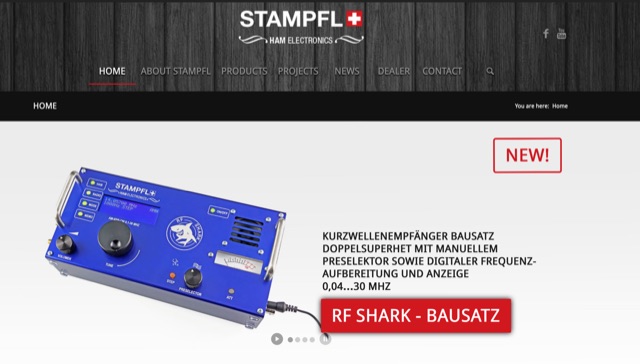
Stampfl is a groundbreaking 3D printing technology that is revolutionizing the manufacturing industry. Developed by a team of engineers and scientists, Stampfl offers a wide range of applications and benefits that are transforming the way products are designed and produced.
With Stampfl, the possibilities are endless. This innovative technology allows for the creation of complex and intricate structures that were previously impossible to manufacture. From prototypes to end-use products, Stampfl can produce high-quality, durable parts with incredible precision and accuracy.
Stampfl also offers a level of customization that is unparalleled. With this technology, designers and engineers can easily modify and optimize their designs, making it possible to create unique and tailored products for specific applications. This level of customization opens up new possibilities for industries such as aerospace, automotive, healthcare, and more.
What is Stampfl?
Stampfl is a revolutionary 3D printing technology developed by Professor Jürgen Stampfl at the Vienna University of Technology. It is named after its creator and is known for its high precision and fast production capabilities.
This technology is based on the principle of additive manufacturing, where objects are built layer by layer using a digital model. However, Stampfl takes this concept to a whole new level by using a wide range of materials and achieving exceptional accuracy.
How does Stampfl work?
Stampfl works by using a process called photopolymerization. This involves exposing a liquid resin to a specific wavelength of light, which causes it to solidify and form a solid object. The resin is contained in a vat, and a platform is submerged in the resin.
A digital model of the desired object is loaded into the Stampfl software, which then slices the model into thin layers. These layers are sent to the 3D printer, which uses a high-resolution projector to project the image of each layer onto the resin. The light causes the resin to solidify, and the platform moves up to allow the next layer to be formed.
This process is repeated layer by layer until the entire object is created. The final result is a highly detailed and accurate 3D printed object that can be used for various applications.
Stampfl technology offers several advantages over traditional 3D printing methods. One of the main advantages is its high precision. The ability to create intricate and complex designs with fine details sets Stampfl apart from other 3D printing technologies.
Another advantage of Stampfl is its fast production speed. The layer-by-layer process allows for rapid production of objects, making it ideal for industries that require quick turnaround times.
Stampfl also offers a wide range of materials that can be used for printing. This includes various types of resins, polymers, and even metals. This versatility makes Stampfl suitable for a wide range of applications, from prototyping to manufacturing end-use parts.
How does Stampfl work?
Stampfl is a revolutionary 3D printing technology developed by Professor Jürgen Stampfl at the Vienna University of Technology. It is based on the principle of stereolithography, which involves the use of a liquid resin that is cured by a light source to create solid objects layer by layer.
The process begins with the creation of a 3D model using computer-aided design (CAD) software. The model is then sliced into thin layers, and each layer is sent to the Stampfl printer. The printer consists of a vat filled with liquid resin and a platform that can move up and down.
When the printing process starts, a light source, usually a laser or a projector, is used to selectively cure the liquid resin according to the shape of the current layer. The platform moves down slightly, and a new layer of liquid resin is spread over the cured layer. The process is repeated layer by layer until the entire object is printed.
Stampfl also offers fast production times compared to traditional manufacturing methods. The curing process is relatively quick, and multiple objects can be printed simultaneously, further reducing the production time.
Another advantage of Stampfl is its versatility in terms of materials. It can work with a wide range of resins, including those with different mechanical properties, colors, and transparency levels. This makes it suitable for various applications, from prototyping to the production of functional parts.
Advantages of Stampfl
Stampfl is a revolutionary 3D printing technology that offers numerous advantages over traditional manufacturing methods. Here are some of the key advantages of using Stampfl:
1. High Precision: Stampfl is known for its exceptional precision and accuracy. It can produce intricate and complex designs with incredible detail, making it ideal for applications that require high precision.
2. Fast Production: Stampfl is capable of producing parts and prototypes at a much faster rate compared to traditional manufacturing methods. This allows for quicker turnaround times and increased productivity.
3. Wide Range of Materials: Stampfl is compatible with a wide range of materials, including plastics, metals, ceramics, and composites. This versatility allows for the production of parts with varying properties and characteristics.
4. Cost-Effective: Stampfl offers cost savings in terms of material usage and production time. It eliminates the need for expensive tooling and reduces waste, making it a cost-effective solution for manufacturing.
5. Design Freedom: Stampfl enables designers to create complex geometries and intricate designs that were previously impossible with traditional manufacturing methods. This opens up new possibilities for product innovation and customization.
6. Reduced Assembly: With Stampfl, it is possible to produce parts with complex internal structures and integrated features, reducing the need for assembly and post-processing. This simplifies the manufacturing process and saves time and resources.
7. Sustainable Manufacturing: Stampfl promotes sustainable manufacturing practices by reducing material waste and energy consumption. It allows for the production of lightweight and optimized parts, resulting in reduced environmental impact.
8. Versatility: Stampfl can be used in a wide range of industries, including aerospace, automotive, healthcare, and consumer goods. It is suitable for both prototyping and production applications, making it a versatile solution for various manufacturing needs.
High Precision
The high precision of Stampfl is made possible by its advanced printing process. The technology uses a layer-by-layer approach, where each layer is carefully deposited and cured to create the final object. This precise control over the printing process ensures that each layer is accurately placed, resulting in a finished product that meets the exact specifications.
Stampfl’s high precision is particularly beneficial in industries such as aerospace, automotive, and medical, where precision is crucial. For example, in aerospace, Stampfl can be used to create complex components with tight tolerances, ensuring optimal performance and safety. In the medical field, Stampfl can produce customized implants and prosthetics with precise fit and functionality.
Furthermore, Stampfl’s high precision allows for the creation of intricate and detailed designs that were previously difficult or impossible to achieve. This opens up new possibilities in fields such as architecture, jewelry, and art, where intricate and unique designs are highly valued.
In addition to its high precision, Stampfl also offers other advantages such as fast production and a wide range of materials. These features make Stampfl a versatile and efficient 3D printing technology that is revolutionizing various industries.
Fast Production
Stampfl is a revolutionary 3D printing technology that offers fast production capabilities. With Stampfl, objects can be printed quickly and efficiently, allowing for rapid prototyping and production of various products.
Stampfl utilizes a layer-by-layer printing process, where a liquid resin is selectively cured by a UV light source. This process is highly efficient and allows for the creation of detailed and precise parts with minimal waste material.
Benefits of Fast Production with Stampfl

There are several advantages to using Stampfl for fast production:
- Time-saving: Stampfl significantly reduces the production time compared to traditional manufacturing methods. This allows companies to meet tight deadlines and quickly respond to market demands.
- Cost-effective: The fast production capabilities of Stampfl can lead to cost savings in terms of labor, materials, and overall production costs. Companies can optimize their manufacturing processes and reduce waste.
- Flexibility: Stampfl offers the flexibility to produce a wide range of products, from small intricate parts to larger objects. This versatility allows companies to explore new design possibilities and create innovative products.
Overall, the fast production capabilities of Stampfl make it an ideal choice for companies looking to streamline their manufacturing processes and bring products to market quickly. With its high-speed printing and efficient production, Stampfl is revolutionizing the world of 3D printing.
Wide Range of Materials
The Stampfl 3D printing technology offers a wide range of materials that can be used for printing various objects. This versatility makes it a popular choice among industries and individuals alike.
Stampfl can work with materials such as plastics, resins, metals, ceramics, and even biological materials. This opens up a world of possibilities for creating objects with different properties and functionalities.
For example, in the medical field, Stampfl can be used to create custom implants and prosthetics using biocompatible materials. This allows for a more precise fit and better integration with the patient’s body.
In the automotive industry, Stampfl can be used to create lightweight parts with high strength and durability. This can help reduce the weight of vehicles, leading to improved fuel efficiency and performance.
Stampfl can also be used in the aerospace industry to create complex parts with intricate geometries. This can help reduce the weight of aircraft and spacecraft, leading to improved efficiency and cost savings.
Overall, the wide range of materials that Stampfl can work with makes it a versatile and powerful tool for various industries. Whether it’s for prototyping, manufacturing, or research purposes, Stampfl offers endless possibilities for creating innovative and functional objects.
Applications of Stampfl
The Stampfl technology has a wide range of applications across various industries. Its versatility and precision make it a valuable tool in many fields. Here are some of the key applications of Stampfl:
1. Prototyping
Stampfl is widely used in the prototyping process. It allows for the quick and accurate production of prototypes, which can be used for testing and validation before mass production. This helps companies save time and money by identifying and addressing any design flaws early on.
2. Biomedical Engineering
Stampfl has made significant advancements in the field of biomedical engineering. It can be used to create custom-made medical implants, prosthetics, and surgical guides. The high precision and biocompatible materials used in Stampfl make it an ideal choice for creating complex and personalized medical devices.
3. Aerospace Industry
The aerospace industry requires components that are lightweight, durable, and have complex geometries. Stampfl can meet these requirements by producing intricate parts with high accuracy. It is used in the manufacturing of aircraft components, such as turbine blades, fuel nozzles, and brackets.
4. Automotive Industry
Stampfl is widely used in the automotive industry for rapid prototyping, tooling, and production of end-use parts. It enables the production of lightweight and complex components, improving fuel efficiency and reducing manufacturing costs. Stampfl is also used in the development of concept cars and customized vehicles.
5. Architecture and Construction

Stampfl is increasingly being used in architecture and construction for creating intricate models, prototypes, and molds. It allows architects and designers to visualize their designs in a tangible form and make necessary modifications before construction. It also enables the production of complex building components with high precision.
6. Education and Research
Stampfl is extensively used in educational institutions and research facilities for teaching and conducting experiments. It provides students and researchers with hands-on experience in 3D printing technology and allows them to explore its potential applications in various fields.

Over the years, I have amassed a wealth of experience and knowledge, which I eagerly share with fellow radio aficionados. Through my writing and active participation in the amateur radio community, I strive to inspire others and provide valuable insights into this fascinating hobby. Engaging in various radio activities, I continue to learn and grow, constantly amazed by the endless possibilities that radio communication offers.

